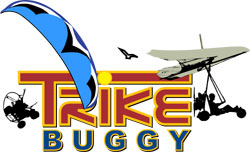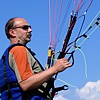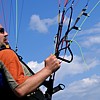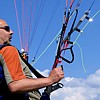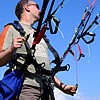Some observations from a few days at the Salton Sea:
Last weekend, I got the chance to fly the TrikeBuggy Bullet with a
Dudek Synthesis Full Reflex wing, size 34. I was impressed at how
nicely the wing inflated with the trimmers in the neutral setting. It
did have a little help from the Bullet's built-in A-Assists, and I
would say that this is one of the easiest wings I've used on the
trike. Many touch and go's later, I went for a little tour up the
coast, but flying alone, it was hard to judge the speed without
another glider nearby.
On Monday morning, the weather was perfect again, so I took a flight
with Bob Peloquin, another TrikeBuggy owner and one of our free flight
instructors at Fly Above All. I was surprised to see the speed
difference between the two wings! He was flying an Ozone Roadster
Large (flat area 28.5m) and I was flying the Synthesis 34m. When I let
the trimmers out, I literally walked away from him - and he has at
LEAST 100 pounds of weight more than I do! Reflex wings are really
fast, and I only used the trimmers and not the speed bar.
Pierre and Bob took a bit of video, and I made a pretty long video of some of my touch & go's and flying around on the Dudek Synthesis 34 wing. The Quicktime version takes awhile to download - be patient, just let it download and it will work, or you can go to the Vimeo version if you prefer.
All in all, I was very impressed with the wing - the inflation was
smooth and consistent (especially with the Bullet's A-Assists), the
taxiing was easy and intuitive and once in the air, the wing simply
CARVED! With the trimmers in, the Synthesis is absolutely one of the
most nimble wings I've flown.
When you let the trimmers out, you have to steer with the wingtip
steering system - easily reached and detached due to the strong
magnets keeping them in place. This is a bit foreign to me, since I'm
not used to it, but the speed is simply amazing! Well worth getting
the hang of.
This wing is so stable when trimmed slow that I think it would be good
for even fairly new PPG and Trike pilots. It also has the range of
speed and great handling that will take a pilot well into their
intermediate phase of flying and beyond. I flew the wing without a
motor as well with a free flight harness, and was able to use thermal
and ridge lift to easily stay aloft quite easily. I didn't have the
altitude to do any maneuvers, but I'd like to put this baby through
some deflations and aerobatics.
The Dudek wings are reasonably priced now, due to the stronger Dollar/Euro exchange rate. This is especially true because the Synthesis glider is so versatile. I'm looking forward to
flying it more soon...
Best,
Chad Bastian
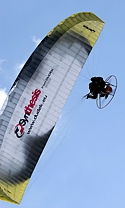 Design Concept Design Concept
A three-dimensional modern design is possible only by the application of computer numerical capacities. Hence widespread use of CAD (Computer Aided Design) programs. There is a lot of other software, too - specialised in calculating aerodynamic forces or pressure distribution. A good program can give you a thorough aerodynamic analysis of the entire body.
Currently we are developing our own design software. It will make our work more efficient and permit us to prepare and tune prototypes much faster, thus making the overall effect even better.
As soon as the first ideas show up on a computer screen, we can create a prototype and test it in all possible conditions. Then, according to the results, we can modify the design, prepare the next prototype and so on, until we reach satisfying wing qualities and consider the paraglider ready for mass production.
Matching the elements
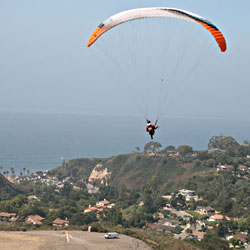 The canopy of a paraglider is a three-dimensional body, which consists of a couple of hundred elements. Its lower surface is smaller in area than its top and is shaped differently. None (!) of the top and bottom sail panels is a rectangle. They are all connected at different angles and, in addition, many of them are twisted along an axis, and, what's more, these axes don't have to be straight lines at all. So, to achieve parts of a three-dimensional body cut from a flat - as it initially is - sheet of cloth, you have to: The canopy of a paraglider is a three-dimensional body, which consists of a couple of hundred elements. Its lower surface is smaller in area than its top and is shaped differently. None (!) of the top and bottom sail panels is a rectangle. They are all connected at different angles and, in addition, many of them are twisted along an axis, and, what's more, these axes don't have to be straight lines at all. So, to achieve parts of a three-dimensional body cut from a flat - as it initially is - sheet of cloth, you have to:
- design the wing in three dimensions
- decompose it into a number of parts
- cast them onto a geometrical plane
Obviously, these things would be very hard to do without a computer. In order to cope with the difficult problem of transforming twisted, concave or convex surfaces into flat panels, we've created highly specialised software. It divides each spatial element into a great number of little triangles and casts them onto a plane. This is just one of many factors resulting in the unique smoothness of our wings' top surfaces. We mention some others below.
Top surface smoothness
At a paragliding fair in Augsburg in 1996 a Pro Design guru, Stefan Stiegler, said, "It's not the lower surface that flies - it's the top one". He meant that in order to achieve good performance it's more important to have an exact airfoil reproduction on the top surface than on the bottom one. Indeed, this "importance factor" amounts to some 70% to 30%. Everybody knows that in a paraglider the airfoil is actually reproduced only at the ribs themselves. Between them the sail bulks, distorting the airfoil section. The situation could be helped by inserting more ribs in the wing, but more ribs mean more suspension lines, greater drag and much worse overall performance. Of course you can leave some ribs unsuspended, but then you will have to fight their tendency to rise above the suspended ones. The problem is usually resolved by modification of the lower surface and rib edges - as we already know, the improvement of the top surface is much more important than a slight degradation of the bottom. This is the construction of VOX.
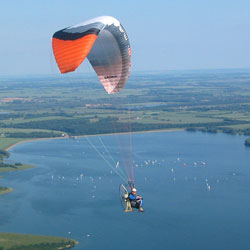 Unfortunately, this solution cannot be applied to better paragliders, since competition wings require so many cells that you would have to suspend every third or even fourth rib. This is too much to be corrected by altering only the bottom surface. The answer to this problem is to fix every second rib together with the suspended rib at the suspension points line, and have it run aslant to meet its correct position at the top surface, thus creating the so-called V-cells. Unfortunately, this solution cannot be applied to better paragliders, since competition wings require so many cells that you would have to suspend every third or even fourth rib. This is too much to be corrected by altering only the bottom surface. The answer to this problem is to fix every second rib together with the suspended rib at the suspension points line, and have it run aslant to meet its correct position at the top surface, thus creating the so-called V-cells.
Such a construction has been pretty common in recent years, yet it still had a couple of unwanted side effects: due to more elements inside the wing, paraglider canopies grew heavier and the pressure distribution was impeded. Both of these factors distinctly worsen wing behaviour during collapses, so something else had to be found.
Finally we decided to modify the idea and so we arrived at V-V technology which, while retaining all of V-cell advantages, should eliminate its drawbacks. To put it simply, the slanted rib is no longer made of one piece, but consists of some upside-down triangles. They are connected to the top surface by their bases, while their tops enter the suspension points. This is yet another solution, greatly increasing the number of man-hours needed (there is a huge increase in the number of elements to be cut, identified and sewn together), but a competition or sports wing that performs as intended is well worth it. As a result we have more cells, fewer lines, only a slight increase in weight and practically no hindrance of air propagation throughout the canopy. This is the construction of MAX and LUX.
Drag reduction
There are two main sources of drag in a paraglider: the canopy shape and suspension lines.
Drag of the canopy can be minimised by altering the wing shape, e.g. refining the airfoil or increasing the aspect ratio. But you can't do this ad lib, because better performance is always linked with worse stability and safety. The only way is to find some compromise. Our experience and that of many other teams shows that the best solution combines greater aspect ratio and thicker airfoil. Such an approach increases performance in a paraglider, while still maintaining it in its original safety class.
This is the way we have chosen for all our wings.
To reduce the drag of suspension lines, you need to decrease their overall length. They can't be simply shortened, as this would drastically affect the paraglider's handling and stability. But it is possible to reduce their number.
You can do this in two ways. Firstly, the wing is designed in such a manner that, without compromising the surface quality, you can suspend the pilot from every n-rib. In the case of VOX this is from every second rib, and in the case of Max and Lux (where we used the V-V technology), every fourth.
Secondly, after thorough analysis of load distribution, it turned out that the heaviest-loaded parts are the front and centre of the wing, while the closer to the trailing edge and wing tips we reach, the less the load is. The auxiliary lines of the suspension points can't be eliminated at will, as the surface will be distorted. But, since the lines at the trailing edge carry less weight, you can attach them to the main suspension lines, thus eliminating the entire lower part of the D-row. You deal with the wing tips in a similar way.
Of course, line diameter counts too, but it is of lesser importance. Drag is created not only by the line itself, but also to a much greater extent by vortices developed both in front and in the wake of the quivering line. In short, it is better to have one line of 2 mm diameter than two of the same length and 1 mm thick.
Zoom factor
Zooming is a way of designing differently-sized gliders of the same type. Not long ago their size was commonly modified just by inserting or removing cells from the middle of the wing. It was the simplest method, yet simultaneously the least accurate.
In zooming, we proportionally size up or down all the dimensions of the wing. As a result all wing sizes have roughly the same flight characteristics (due to the Reynolds effect they are never identical anyway).
CSG - Canopy Shape Guard - is our unique system controlling canopy coherence. It is because of this system that our wings are equally tensioned, smooth, stable and... simply remarkable.

CSG consists of a number of lesser systems:
- VS (V-shaped Supports) - they are there to ensure upper surface smoothness, exact aerofoil reproduction on entire wing span, better load distribution and possible small number of suspension points.
- RSS (Reinforcing Strap System) - an independent reinforcements net on lower surface, strengthening and stiffening all construction.
- OCD (Optimized Crossports Design) - the intercellar openings have carefully designed shapes and are optimally placed between stress lines in the ribs, in order to ensure efficient pressure distribution in the canopy and its quick inflation.
- CCS (Closed Dell Structure) - this is a number of closed cells in most important locations. It?s goal is to hinder the backflow from the cells out and thus to facilitate their refilling and canopy recovery in case of a collapse.
Canopy Shape Guard effectively stiffens the wing along all its span, practically eliminating any lateral canopy work. Its only flaw are the increases in weight (about 1 kg), material- and labour consumption, and of course in overall costs. Yet it is well worth the sweat, as in turn we get a no-compromise product of highest performance and quality, that above all is able to keep its planned parameters for a long, long time.
Not every wing features all DRA subsystems - you will find details in each wing description.

DRA - Dudek Reflex Airfoil -applied in PPG wings fully autostabilised arofoil, based on long years of research and experience. In our variant we managed to get rid of typical flaws associated with these aerofoils.
Risers functionality
We are constantly adapting riser design to growing needs of our customers. Each riser is marked with different colour. All risers have an optionable speed-system.

Easy Launch Riser - Split 'A' riser makes for easier launch and 'big ears'
As in all other elements of the wing, the risers too must be constantly adjusted to the ever-increasing needs of the pilots. As a standard, every Dudek wing is equipped with a split A riser. Most of the lines go to the main riser, and the additional one has just one or two outer lines.
There are two advantages such a solution. Firstly, the big ears are a lot easier to introduce - you no longer have to reach high above the quick-links, and the taut lines do not hurt your fingers. Secondly, a start is much easier, too. With a dynamic push every wing has a tendency to form a horseshoe, i.e. to inflate the tips faster than the centre. The pilot can reduce this effect by grabbing only the main A risers, leaving the outer part hanging. The leading edge will then be pulled only in the central part and the tendency for the tips to speed up will be eliminated.
When the wing is in the air, you can recognise the risers without hesitation. But when the wing is lying on the ground it can be difficult, especially while preparing for a reverse launch and the risers just form a twisted bundle. That's why we have distinctly marked the main A risers with yellow tape, so it is easier for you to find the correct risers and your instructor can instantly see if you are right.
All our gliders have three-row risers equipped with a speed-system.

Trim - a trimming system for additional angle of attack regulation. Used mainly in PPG wings.
This system features replaceable trim straps. After prolonged or intensive operation they need to be replaced, as they get damaged by buckle edges.
Our new trimmer straps have a visible scale with negative (blue) and positive (red) areas and marked neutral position. Getting the buckle in red area means that the wing is flying faster, while moving it in the blue causes the wing to fly slower. Neutral position is a suggested take-off position, notwithstanding that each pilot will have his/her own preferences worked out in time. Applied markings help you remember characteristic settings, e.g. max speed in level flight, easy take-off in strong wind etc.
Straps are finished with loops for easier operation.
See replacing strap instructions.

Easy Keeper - indigenous way to hold the brake handles at the risers that keeps them firmly in place, while both attaching and releasing goes smoothly and easily.

DCT - Double Comfort Toggle - makes possible to have your brake handles as you like them, in stiff or soft configuration.

Tip Steering Toggles - Our newest idea, featuring additional miniature handles that steer the stabilizers. It is a great improvement on long flights, when opened trimmers and full speedbar make steering much harder.
Prior to grabbing miniature TST-handles (Tip Steering Toggles) pilot places the main steering handles in a special Toggle Docking Stations, equipped with strong neodymium magnets. In this way you can comfortably steer the wing via TST handles, not worrying about the brakes getting tangled.

Cleaning Slots - Located at the wing tips make removal of dirt much easier.
|
